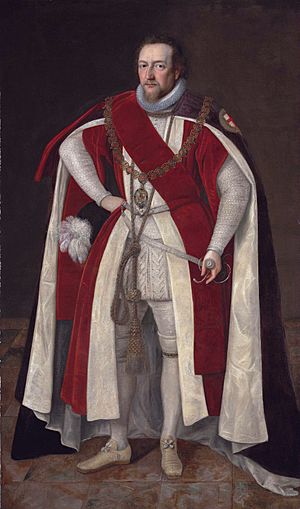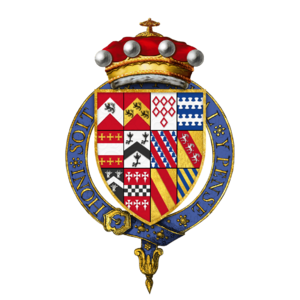Henry Brooke, 11th Baron Cobham facts for kids
Henry Brooke, 11th Baron Cobham (born November 22, 1564 – died February 3, 1618) was an English nobleman. He was the lord of the Cobham estate in Kent. He became involved in a serious secret plan against King James I, which led to his imprisonment.
Life of Henry Brooke
Henry Brooke was the son of William Brooke, 10th Baron Cobham, and his second wife, Frances Newton. He studied at King's College, Cambridge.
In 1597, after his father passed away, Henry took over his father's important job as the Lord Warden of the Cinque Ports under Queen Elizabeth I. This job meant he was in charge of several important coastal towns in England.
Soon after King James I came to the throne, Henry Brooke was accused of being part of a serious secret plan in 1603. His brother, George Brooke, was executed for his part in these plans. Henry was sent to the Tower of London by King James I. Some people believe the king wanted to take over the Cobham family's lands.
Henry Brooke was the second husband of Lady Frances Howard. She was the daughter of Charles Howard, 1st Earl of Nottingham.
Some people think Henry Brooke might have been the inspiration for famous characters in plays and books from his time. For example, some believe he might have been the model for Shakespeare's character, Falstaff. Falstaff was originally named "Oldcastle," and Sir John Oldcastle was an ancestor of Lord Cobham. However, it's also thought that Falstaff might have been based more on Henry's father, William Brooke.
Secret Plans Against the King
People at the time described Henry Cobham as a kind but not very clever man. He did not want King James I to become king, similar to another nobleman, Thomas Grey. Cobham's dislike for James might have come from disagreements about religious rules. Before King James's time, Cobham didn't seem very involved in politics. His brother, George Brooke, however, was very active in radical religious politics.
In 1603, the first year King James I ruled, both Henry and George Brooke were involved in secret plans against the king. George Brooke joined a plan called the "Bye Plot." This plan involved two Catholic priests who wanted to kidnap the king and his advisors. They hoped to force them to be kinder to English Catholics.
At the same time, Henry Cobham and Lord Grey were part of another plan called the "Main Plot." They planned to gather a large sum of money to hire an army. Cobham was supposed to talk with a European prince, the Princely Count of Arenberg, to get money from Spain. The idea was that if they succeeded, they would remove King James and put Lady Arabella Stuart on the throne instead.
It's very likely that the offers from the Princely Count Arenberg were not serious. Spain was already in a lot of debt and had lost many ships. It was probably not in a position to offer such a huge amount of money for a risky plan. However, Cobham believed the offers. He even spoke with Sir Walter Raleigh about contacting Arenberg and was getting ready to travel.
But the "Bye Plot" was discovered. George Brooke might have told on his brother to avoid being executed. Because of this, information about the "Main Plot" came out. Grey, Cobham, and Raleigh were all sent to the Tower of London. During their trial, the evidence seemed confusing, especially for Raleigh. The people involved in the "Bye Plot" were executed in 1603. Those from the "Main Plot" were left in the Tower. In 1604, Cobham lost his special honors as a Knight of the Garter.
Cobham, who was old and sick, was finally released from the Tower in 1618. He passed away shortly after in a small apartment.
Marriage
In 1601, Henry Brooke married Frances Howard (around 1572–1628). She was the second daughter of Charles Howard, 1st Earl of Nottingham, and had been married before. After her husband was found guilty of a serious crime against the king in 1603, the king allowed Frances to live at Cobham Hall in Kent for the rest of her life. She lived there until she died in 1628.
| Political offices | ||
|---|---|---|
| Preceded by The Lord Cobham |
Lord Warden of the Cinque Ports 1597–1603 |
Succeeded by The Earl of Northampton |
| Lord Lieutenant of Kent 1597–1603 |
Succeeded by The Lord Wotton |
|
| Peerage of England | ||
| Preceded by William Brooke |
Baron Cobham 1597–1603 |
Succeeded by William Brooke (under attainder) |



